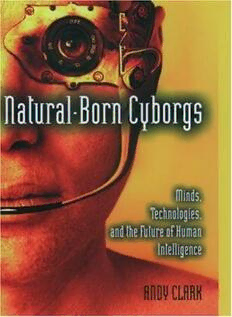
Natural-Born Cyborgs: Minds, Technologies, and the Future of Human Intelligence PDF
Preview Natural-Born Cyborgs: Minds, Technologies, and the Future of Human Intelligence
Natural-Born Cyborgs: Minds, Technologies, and the Future of Human Intelligence ANDY CLARK OXFORD UNIVERSITY PRESS NATURAL-BORN CYBORGS This page intentionally left blank NATURAL-BORN CYBORGS Minds, Technologies, and the Future of Human Intelligence A N D Y C L A R K 2003 Oxford New York Auckland Bangkok Buenos Aires Cape Town Chennai Dar es Salaam Delhi Hong Kong Istanbul Karachi Kolkata Kuala Lumpur Madrid Melbourne Mexico City Mumbai Nairobi São Paulo Shanghai Taipei Tokyo Toronto Copyright © 2003 by Andrew J. Clark Published by Oxford University Press, Inc. 198 Madison Avenue, New York, New York 10016 www.oup.com Oxford is a registered trademark of Oxford University Press All rights reserved. No part of this publication may be reproduced, stored in a retrieval system, or transmitted, in any form or by any means, electronic, mechanical, photocopying, recording, or otherwise, without the prior permission of Oxford University Press. Library of Congress Cataloging-in-Publication Data Clark, Andy, 1957- Natural-born cyborgs: Minds, technologies, and the future of human intelligence / Andy Clark. p. cm. Includes bibliographical references and index. ISBN 0-19-514866-5 1. Technology—Social aspects. 2. Neuroscience—Social aspects. 3. Artificial intelligence—Social aspects. 4. Human–computer interaction. 5. Cyborgs. I. Title. T14.5 .C58 2003 303.48'34—dc21 2002042521 1 3 5 7 9 8 6 4 2 Printed in the United States of America on acid-free paper For Mike Scaife, 1948–2001 This page intentionally left blank Acknowledgments This book owes large debts to many well-established ideas and research programs. All I have done is reshape these ideas, putting them into more direct contact with recent technological developments and with the an- cient questions of who, what, and where we are. In constructing the foun- dations of this mosaic, I am most deeply indebted to the works of Daniel Dennett and Ed Hutchins. I also owe much to a brief but fruitful collabora- tion with David Chalmers (see our paper, “The Extended Mind” in Analysis 58, no. 1 [1998]: 7–19). In trying to see how specific new technologies fit in, I have been greatly helped by the works of Don Norman, Neil Gershen- feld, Kevin Kelly, Howard Rheingold, Yvonne Rogers, and Mike Scaife. Mike died, unexpectedly, while I was working on this book, and I respectfully dedicate it to his memory. Various other parts of the picture show the influence of Jerome Bruner, Richard Gregory, Donna Haraway, N. Katherine Hayles, David Kirsh, John Haugeland, Merlin Donald, Brian Arthur, Doug North, John Clippinger, Esther Thelen, and Linda Smith. Large but more subterranean influences include Merleau-Ponty, Heidegger, Lev Vygotsky, J. J. Gibson, Gregory Bateson, and Bruno Latour. I was greatly inspired in the early days of this project by some interac- tions with N. Katherine Hayles, and with the organizers (especially Tom Foster, Louise Economides, and Laura Shackelford) of a round-table dis- cussion that formed part of the Thinking Materiality workshop held at In- diana University, Bloomington, Indiana, in March 2000. 8 ACKNOWLEDGMENTS Works of fiction that had a special impact on me include pieces by Bernard Wolfe, Neil Stephenson, William Gibson, Bruce Sterling, Maureen McHugh, and Warren Ellis (Limbo, Snow Crash, Neuromancer, Holy Fire, China Mountain Zhang, and Transmetropolitan, respectively). In keeping with my central theme, blame must also be shared by some of the key environments in which this work formed and developed. These include the School of Cognitive and Computing Sciences (and especially the Interact Lab) at the University of Sussex, UK; the Philosophy-Neuro- science-Psychology program, which I had the good fortune to direct for seven years at Washington University in St. Louis; the Santa Fe Institute; and most recently the Cognitive Science Program at Indiana University, Bloomington. Thanks too to Barbara Gorayska, Jacob Mey, Chrystopher Nehaniv, and the Cognitive Technology Society for involving me in their important work. Some passages from the Introduction originally appeared in a short piece (“Natural-Born Cyborgs”) electronically published by John Brockman as part of the Edge/Third Culture series. Thanks to John Brockman for per- mission to use this material here. This book would not exist but for the support and encouragement of many people: my agents, John Brockman and Katinka Matson; Kirk Jensen of Oxford University Press; my wife and partner, Pepa Toribio; my mother and father, Christine and James Clark; Gill Banks; Miguel Toribio-Mateas, and all the close friends and family who have helped shape my thoughts and experiences over the years. My extra-large cat, Lolo, did a fair amount of shaping too. ACKNOWLEDGMENTS 9 Contents Introduction 3 CHAPTER 1 Cyborgs Unplugged 13 CHAPTER 2 Technologies to Bond With 35 CHAPTER 3 Plastic Brains, Hybrid Minds 59 CHAPTER 4 Where Are We? 89 CHAPTER 5 What Are We? 115 CHAPTER 6 Global Swarming 143 CHAPTER 7 Bad Borgs? 167 CHAPTER 8 Conclusions: Post-Human, Moi? 197 Notes 199 Index 221
